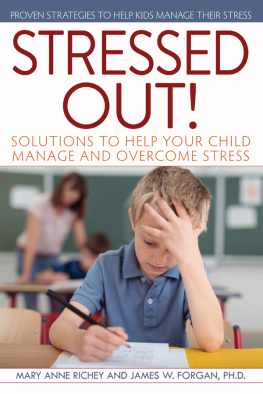
Dedication
Jim dedicates this book to his amazing and beautiful daughter, Emily, remembering the times theyve spent together reading, camping, and laughing.
Mary Anne dedicates this book to her wonderful grandchildren and all of the devoted teachers she has known who have gone above and beyond to make a difference in the lives of girls with ADHD.
Acknowledgements
Projects like this require the work of many individuals, and wed like to thank Jodi MacNeal for her editing expertise, Dr. Marshall Teitelbaum and Dr. Tommy Schechtman for sharing their expertise on diagnosis and medical management of ADHD, Dr. Judith Aaronson-Ramos for her suggestions for reviewing alternative dietary treatments, the families who contributed their experiences, and our spouses for their loving support.
Copyright 2014 Prufrock Press Inc.
Edited by Lacy Compton
Cover and layout design by Raquel Trevino
ISBN-13: 978-1-61821-210-8
No part of this book may be reproduced, translated, stored in a retrieval system, or transmitted, in any form or by any means, electronic, mechanical, photocopying, microfilming, recording, or otherwise, without written permission from the publisher.
At the time of this books publication, all facts and figures cited are the most current available. All telephone numbers, addresses, and website URLs are accurate and active. All publications, organizations, websites, and other resources exist as described in the book, and all have been verified. The authors and Prufrock Press Inc. make no warranty or guarantee concerning the information and materials given out by organizations or content found at websites, and we are not responsible for any changes that occur after this books publication. If you find an error, please contact Prufrock Press Inc.
 | Prufrock Press Inc.
P.O. Box 8813
Waco, TX 76714-8813
Phone: (800) 998-2208
Fax: (800) 240-0333
http://www.prufrock.com |
Chapter 1
Girls and ADHD
SELF-ASSESSMENT: Where Am I Now?
Each self-assessment helps you reflect on your daughter and your parenting practices and is a preview of the chapters content.
1. When I think about myself and where I am emotionally right now, I
a. am still deciding if she really has ADHD or not.
b. am overwhelmed with all of the things she needs and that I need to do to help.
c. know she has ADHD, and Im ready to take action to help.
d. am hoping this is a phase and that she will quickly outgrow this.
2. My daughters type of ADHD is
a. Hyperactive-Impulsive.
b. Inattentive.
c. Combined Type.
d. I dont know.
3. My daughters ADHD occurs with
a. anxiety.
b. depression.
c. low self-esteem.
d. learning problems.
e. other.
f. none of the above.
4. When I think about discussing my daughters ADHD with our extended family, I
a. wouldnt touch it with a 10-foot pole.
b. have already had that conversation.
c. have it on my to-do list.
d. believe they will be warm and supportive.
5. When I think about my daughter and her ADHD, I believe
a. she has more strengths than weaknesses.
b. she has more weaknesses than strengths.
c. she has an equal number of strengths and weaknesses.
d. Im unsure about exactly what she needs.
There is no doubt that raising a girl is difficult, but raising a girl with Attention Deficit/Hyperactivity Disorder (ADHD), whether Inattentive Type (what once was called ADD) or the Hyperactive-Impulsive Type, is even tougher. When you have a girl with ADHD, you may face issues that generally arent on other parents radar screens, such as:
impulsivity in acting before considering the consequences,
organizational problems,
intense emotional displays,
excessive talking,
forgetfulness,
fragile self-esteem,
self-doubt,
constant procrastination,
difficulty with time management,
daydreaming and missing information,
underachievement,
co-occurring disorders,
relationship issues, and
social difficulties.
Fortunately, there are professionals and resources to help you work through many of the parenting challenges of raising girls with ADHD. You dont have to conquer everything on your own. With some effort, you can find support groups with other parents of girls with ADHD (see http://ADHDaware.com or http://Chadd.org), valuable books, and professionals such as counselors, psychologists, or medical doctors. Locating the right people to help you takes some energy, time on the phone and Internet, and research, but it is worth the effort. Not only will you feel supported, but youll also be making an investment in your daughter. In our own parenting and private practices, we know it is much better to be proactive and provide assistance to ward off problems than to be reactive and face even larger problems.
If you do not have a professional to help guide you, dont worry. We are sharing some of our most valuable tips and strategies with you. At the end of each chapter, you will find points to consider and action steps you can take right away to help your child. Share these with your spouse or a family member so youll have an ally in choosing the best strategies for supporting your daughter in school and at home. And in most chapters we link you to specific steps for creating a personalized Dynamic Action Plan (see ). The beauty of your Dynamic Action Plan is that it will allow you and your daughter to build upon todays successes while following a plan for her promising future.
What Makes Parenting Girls With ADHD Different From Parenting Boys With ADHD?
Many people are familiar with how ADHD presents in boys but are less clear about its presentation in girls. In addition to the obvious boy-versus-girl gender differences, there are distinct differences in the presentation and effects of ADHD in boys versus girls. This is an area of emerging research, so always be on the lookout for new information. In our review of the literature of the differences in ADHD in girls and boys, we found that girls with ADHD:
are diagnosed with ADHD at an older age;
are more frequently diagnosed with inattention and have less hyperactivity and impulsivity;
have more emotional comorbidities during the teenage years;
have a greater likelihood of internalizing problems and difficulty regulating emotions, which can lead to self-esteem issues;
have increased feelings of guilt and self-doubt;
have more hormonal issues, specifically estrogen and its effects on medication;
can have greater risk of early sexual activity;
experience more friendship difficulties;
have greater turmoil in the mother-child relationship;
struggle more with societal expectations, which traditionally have expected girls to be more nurturing and accommodating;
may be held more accountable for poor organization and sloppy papers in school, which may be excused as typical boy behavior in males;
may work harder to compensate for or hide their symptoms in an effort to meet parent/teacher expectations;
may be misdiagnosed with other forms of psychopathologyfor example, inattention and poor peer interaction may be misdiagnosed as depression;
have differences in brain structure and development;
have lower levels and different manifestation of Oppositional Defiant Disorder and Conduct Disorder than malesgirls may be more likely to have covert behaviors like lying whereas boys may have more overt, aggressive symptoms like physical aggression;
Next page













